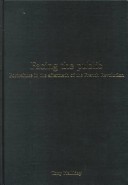Critical Perspectives in Art History
1 total work
Facing the Public: Portraiture in the Aftermath of the French Revolution
by Tony Halliday
Published 10 February 2000
This work examines the effect of the French Revolution on portrait painting. Portraits were the most widely commissioned paintings in 18th-century France. But most portraits were produced for private consumptions, and were therefore seen as inferior to art designed for public exhibition. The Revolution endowed private values with an inprecedented significance, and the way people responded to portraits changed as a result. Art historians have traditionally concentrated on art associated with the public events of the Revolution. Ironically, it was public art whose production was most disrupted by political developments. Seen from the perspective of portrait production, this history of art during the Revolution looks very different, and the significance of the Revolution for attitudes to art and artists in the 19th century and beyond becomes clearer.
